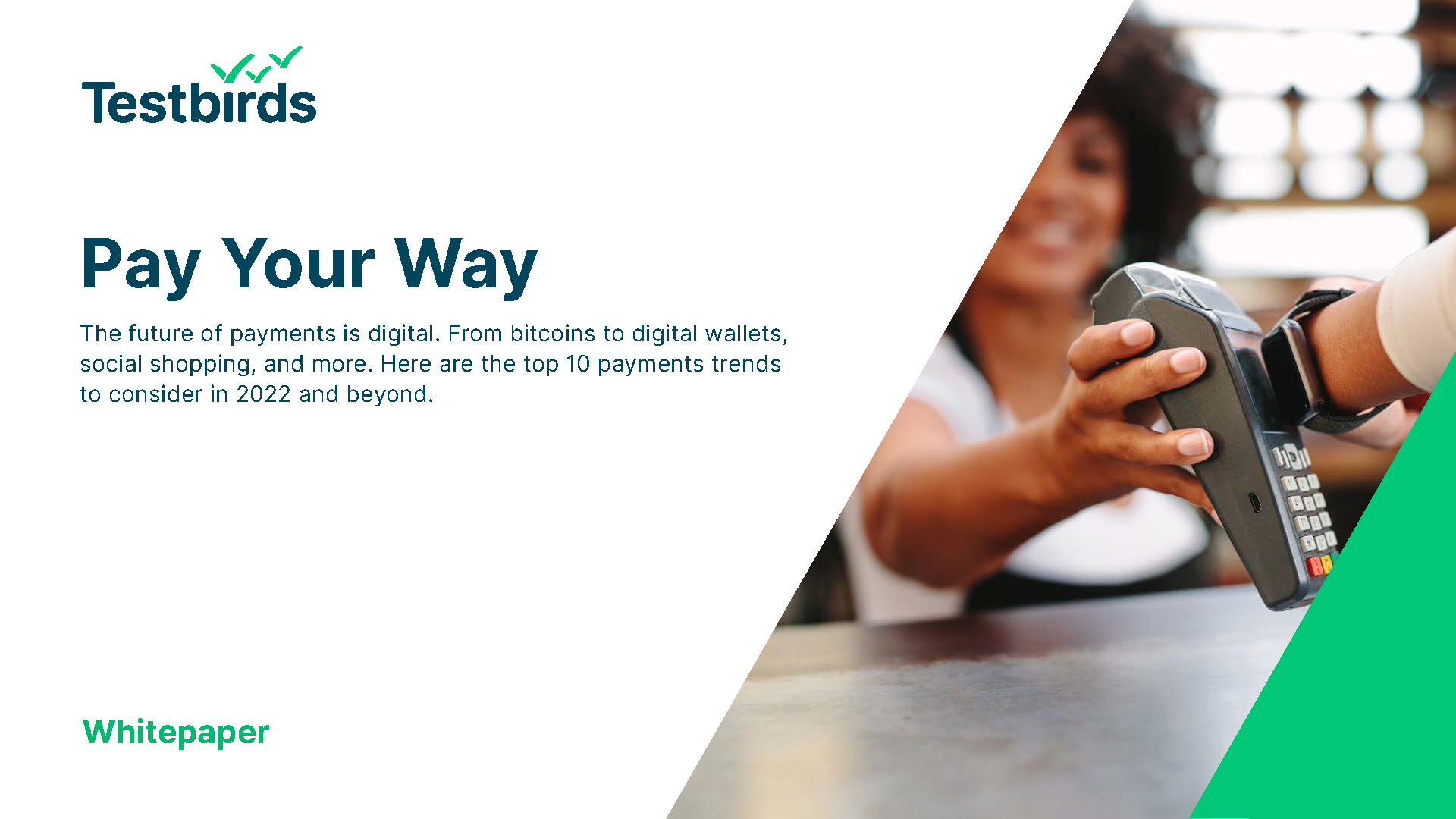Crowdtesting in the banking, finance and insurance industry
The banking, finance, and insurance industry is in the midst of change. QA, UX, and data security are now becoming key competitive advantages.
Meet changing demands and secure trust
When developing your online payments solution or using a third-party product, you need to be 100% sure of its performance, reliability, and security. But can you test with actual customers and with real banks? Can you use real account data? Do you know if it works across borders and that data is accurate regardless of where and how a transaction is made?
Internal testing can’t replicate the real world. Getting things right is good for business.
Show moreCustomers, whether individuals or merchants, must be able to trust that their money and data are in safe hands. Security, in particular, is essential because mistakes and breaches can be costly. For e-commerce retailers, Symantec’s research shows that the ‘average cost for each record breached’ is US$172. Every breach. Then add in the cost of losing customers.
To build trust, every aspect of your solution must work exactly as intended. Is your network secure and can it handle a high number of concurrent payment requests? Does your solution integrate with a variety of other devices? What about functionality – does it calculate prices properly and add taxes? Is performance fast and dependable at peak periods?
This is particularly important when keeping up with ever-changing customer demands.
Show lessCrowdtesting gives you real-world insights
Our payment testing is developed to ensure a flawless payment journey with the power of people. By using actual consumers to make real transactions using live payment methods, we can comprehensively test your digital solution to ensure it is secure, user-friendly, accurate, and dependable – from any location and any device.
All outside of a lab environment.
Show moreWith crowdtesters in 193 countries matching specific target audiences and account holders of all kinds, you can target regional businesses and make sure that any data and money transferred is correctly sent and received, and in a format that fits local standards.
No matter your specific industry, crowdtesters can ensure an optimized customer experience.
Acquirers and processors can thoroughly test the payment flows and processes they provide to clients and uncover any issues that may cause lost sales or loss of trust. Issuers receive detailed and unbiased feedback on their digital banking app or website’s customer experience, such as when opening an account and applying for a loan.
Payment networks can be tested from any location to ensure that integrated solutions work flawlessly, and authentications are triggered successfully, in accordance with local and global regulations.
Gateways and facilitators can gain deeper insights into their payment flows, whether in-store, online, laptop, phone, chip, or contactless – wherever, whoever, whenever, and whatever. Merchants can use our crowdtesters to check the entire customer journey, from user experience, POS, and checkout processes to shipping, delivery, and refunds/returns.
And all is done with data security in mind. All sensitive information is protected according to German & European NDA & DPA standards. Strict tester and client agreements enforce high levels of security and confidentiality for all stakeholders.
Show lessBuild trust and create a great customer experience
Online payment & authentication: Trust the process
For individuals and businesses alike, it is vitally important that online transactions work as intended, are secure, and provide a positive and frictionless customer experience. Especially when it comes to dealing with a global audience. Testbirds has helped multiple clients ensure transactions run smoothly by testing their solutions in multiple locations, and with live bank accounts and payment methods in real-world conditions.
For one client, our testers would deposit and withdraw money to and from their digital wallet and report back on how well the process flow wasFor one client, our testers would deposit and withdraw money to and from their digital wallet – to one or more countries – and report back on how well the process flow was – from how long everything took to whether there were any bugs or other issues.
Another client wanted to test that their credit cards met 3DS2 and PSD2 protocols in specific countries when money was transferred to a specific bank or merchant. Crowdtesters were able to conduct the transactions from their country of origin and check payment validations and authentications and provide feedback on the process flows.
A third client used our crowdtesters to validate their payments across a range of scenarios. This included introducing forced errors, such as inputting the wrong card and CVC numbers. They would also conduct routine tests to ensure a promotion code could be correctly used with a purchase and that navigation was user-friendly and all information was displayed correctly.
Show lessAIS, PIS & Open Banking connections: Connect the dots
As more businesses and BFSI’s extend their reach around the world, open banking solutions using multiple open APIs, that connect to a variety of third-party apps and services, are becoming more popular. This is, unsurprisingly, seeing a rise in service providers seeking AIS and PIS licenses. Such access to customer financial data, alongside the development of new payment solutions, means security and accuracy are extremely important. This is exactly what our crowdtesters have helped confirm for a variety of clients.
One client wanted to ensure that their customer data could be correctly accessed by banks and insurance companiesOne client wanted to ensure that their customer data, which was used to assess their financial health (to get a mortgage, health insurance) could be correctly accessed by banks and insurance companies – eliminating the need for paper records to be manually checked. Our crowdtesters would then use the client’s widget and try to access the client’s platform. Additionally, they requested data from banks in different countries to check whether the data received was understandable and could be standardized to fit their country of residences’ requirements. Overall, they would then report on the connection’s success (or not), the quality of the connection, the trustworthiness of the process, communication, and any challenges.
A second client, whose product enables payments with direct connections to any supporting banks – using a variety of payment types from links to QR-codes – wanted to validate each connection. Our crowdtesters would then make small payments from their accounts to another and/or to the client via banks in specific countries. They could then report on the success or failure of each transaction.
Show lessPoint-of-Sale systems: Pay as you go
Whether a customer is using their own credit/debit cards, prepaid card or a device (watch or phone) that is connected to their bank, each transaction must be fast, easy, and secure. But with the range of ever-changing devices, operating systems, and cards available (across countries), it’s an ongoing challenge to ensure that they connect and work as optimally as possible.
The diversity and wide-ranging geographic locations of our crowdtesters ensure that any device and usage scenario can be tested.
One client recently needed us to thoroughly check their e-commerce and physical POS systemsOne client recently needed us to thoroughly check their e-commerce and physical POS systems in a specific country using various cards not from that region. Additionally, to check that the branding and information noted on their physical POS system was correct. Our crowdtesters then made transactions both online and at physical locations (while checking the branding, etc., on the machines), and documented the payments.
For another client, our crowdtesters’ geographical range was essential as they needed to test their POS devices in specific locations and at certain merchants. Our testers were able to visit local stores, make a purchase on the device, and validate that it worked correctly using different issuers.
A third client wanted to test that their mobile POS app, which was sold exclusively to merchants, could correctly receive payments. Our chosen crowdtesters were also merchants and used the app for two weeks with their customers. They could then validate that the app worked correctly on their specific devices and for that payment method.
Show lessFlawless payment journeys with crowdtesting
Our global, hand-picked crowdtesters cover almost any target group you can imagine and if not, we can find them for you. We make sure you get real user insights on the state of your processes and how they are perceived.
We can create secure, tailor-made payments testing solutions that use real people and live accounts from 193 countries around the world. With our experience in payments testing, we help you to provide an experience your customers will love. Ensure that cross-border transactions and data is safe and secure, improve customer trust and satisfaction, increase revenue, and optimize your BFSI solutions to gain and retain customers.
Pay Your Way
We provide you with the latest insights from the world of crowdtesting
Stop guessing if your product meets the expectations of your users and start making decisions based on facts.
Do you have questions about testing in the banking, finance, and insurance industry?
Would you like more information on how we can help you make your digital products even better? Just send us a message, one of our solution consultants will be happy to get in touch with you.
Three hands-on examples
Digital application routes
If your digital application process doesn’t function properly, whether due to bugs or poor user guidance, you will lose potential customers. The conversion rate drops and sooner or later your turnover will also drop. To prevent this, extensive QA and UX testing is essential.
In the area of QA, for example, the Crowd conducts bug tests and thus ensures that your application runs perfectly on every device, with every software version, every operating system, and every browser.
In the area of UX, remote usability videos, among other services, give you the chance to watch testers from your target group use your application, so you can easily see where difficulties arise.
Artificial Intelligence (AI)
The use of artificial intelligence (AI) is becoming increasingly important for companies in the financial industry. But new technologies also bring new challenges. How do I check the quality of my chatbot, where do I get training data? With the help of our chatbot and AI tests, you can uncover weaknesses in information processing and natural language processing.
Training data, which can include dialects and background noise if desired, will help you close language gaps and provide your customers with an optimal experience.
Digital factories
More and more banks and insurance companies are setting up their own digital factories to develop and implement new technologies and ideas. They rely on agile development methods with short sprints. Thanks to our global Crowd, which is ready for action 24/7, Crowdtesting provides you with optimal support.
We implement your tests flexibly and promptly so you don’t have to wait long for first results. In addition, bugs can easily be converted into feature requests on Jira and other issue trackers.
The biggest “pains” for banks and insurance companies
It doesn’t matter whether we’re talking about mobile banking apps, digital insurance advisors, or optimized application routes. At the end of the day, every digital service in the banking and finance sector can be assessed according to three criteria that are always valid:
Does it work? Is it easy for customers to use? Is it secure? Therefore, in terms of testing those digital services, we’re talking about the areas of quality assurance (QA), usability and user experience (UX), and security.
In the area of QA, our wide range of testing services ensures that your digital product works flawlessly and without problems. In the financial sector especially, a non-functioning product quickly reflects on your overall image and thus on your brand.
The same applies to data security. It’s not only following the introduction of GDPR that consumers have a fine feeling for their data and its protection.






